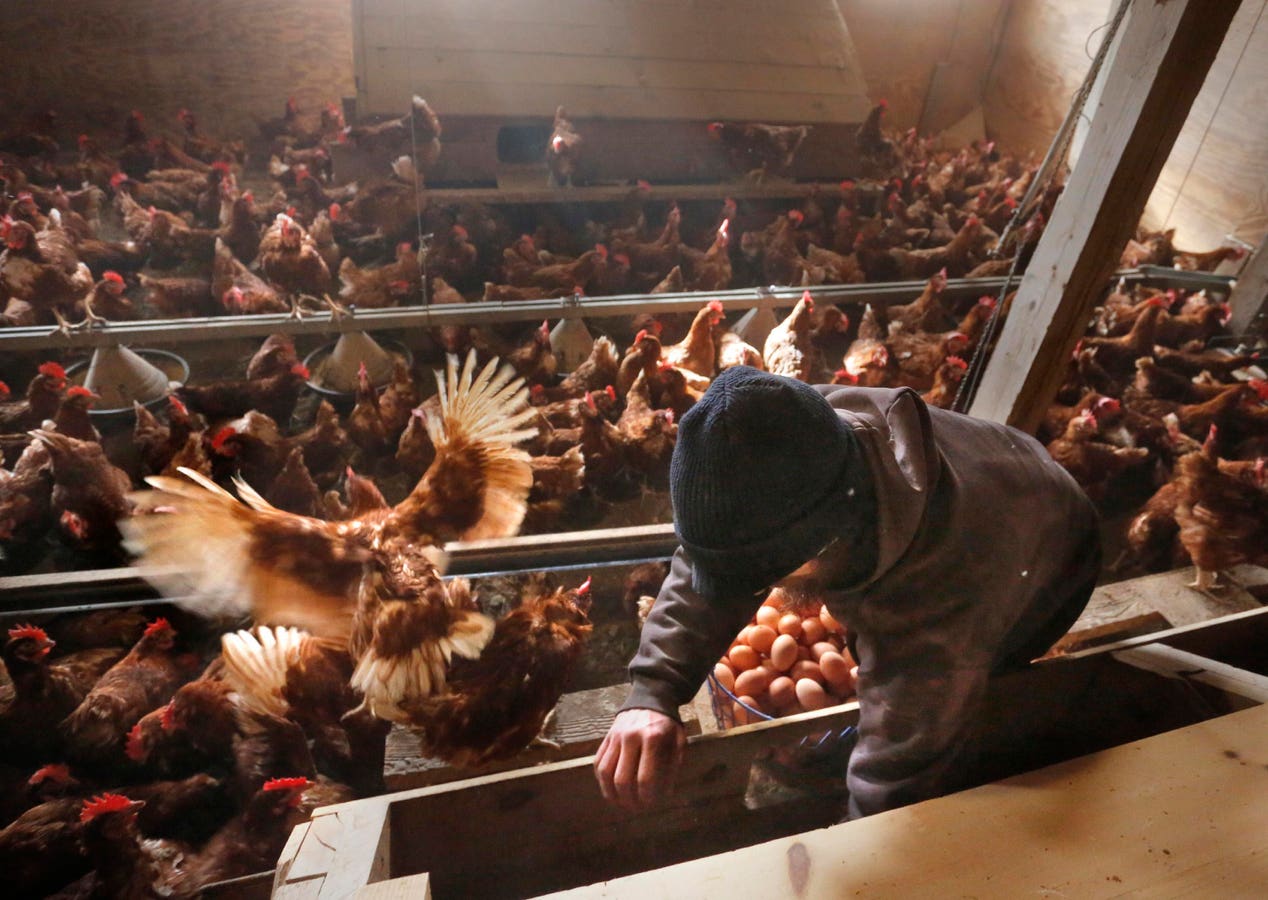Avian influenza, commonly known as Avian Flu or bird flu, is a type of influenza virus that primarily affects birds, but as recent reports have shown, can also infect humans and other animals including cattle. The origins of avian flu can be traced back to aquatic birds, where the virus occurs naturally. However, it can spread rapidly to domestic poultry leading to significant health, economic, and agricultural implications. According to the Centers for Disease Control and Prevention (CDC) since the latest Highly Pathogenic Avian Influenza H5N1 (HPAI) outbreak in 2022 over 82 million birds in 48 U.S. states have been culled and 36 dairy herds have been affected. The USDA has tested retail ground beef for the virus and maintains that the US meat supply is safe and they continue to test retail milk samples as well since discovering in mid April that 1 in 5 milk samples from grocery stores across the nation tested positive for Avian Flu – adding even more anxiety for our shoppers and chinks away at the trust the safety of our food supply. The World Health Organization strongly advises that people consume only pasteurized milk, in which bacteria and viruses have been killed, and avid consuming raw milk.
Prices for farm-level eggs fell by 23.2 percent in March 2024 after increasing by 53.8 percent in February. As you know, the outbreak of Avian Flu that began in 2022 contributed to elevated egg prices in some supermarkets up to $7 a dozen; the Bureau of Labor Statistics reports the national average in cities hit the high point in January of 2023 at $4.82 for a dozen grade A large eggs. In March 2024, prices for farm-level eggs were 35.7 percent lower than March 2023, when prices remained high following the initial onset of HPAI in 2022. After the egg prices peaked in January 2023, they declined or stabilized through much of 2023. Now, with new confirmations of Avian Flu in November 2023, we are witnessing a steady price increases since December of 2023. Farm-level egg prices are predicted to increase 22.3 percent in 2024, with a prediction interval of up to 123.4 percent. According to the USDA Economic Research Service, egg prices are the most volatile category tracked leading to the wide prediction interval.
Historical Context
The history of avian influenza dates back to the early 20th century, with the first significant recorded outbreak occurring in Italy in 1878. The disease was initially thought to be unique to birds until the first case of human infection was documented in Hong Kong in 1997. This incident involved the H5N1 strain, one of the most virulent forms of the virus, which raised global alarms due to its severe impact on human health and high mortality rate. Since then, multiple outbreaks of various strains of avian flu, including H7N9, H5N8, and H5N6, have been reported around the world. These outbreaks have predominantly affected Asia, Europe, and Africa, with sporadic reports in North America.
Transmission and Symptoms
Avian flu viruses are highly contagious among birds and can spread through direct contact with infected animals or contaminated environments. In humans, the infection usually occurs through direct contact with infected birds or surfaces that have been contaminated with their secretions or feces. Human symptoms of avian flu are similar to those of regular seasonal flu, including fever, cough, sore throat, and muscle aches. Severe cases can lead to pneumonia, multiple organ failure, and death.
Global Impact
The global impact of avian influenza is significant. Economically, outbreaks lead to massive losses for the poultry industry due to the culling of infected birds and trade restrictions imposed to prevent the spread of the virus. For instance, during the 2015 outbreak in the United States, over 50 million birds were culled, resulting in billions of dollars in economic losses. In 2023 the Department of Agriculture paid poultry producers more than half a billion dollars for the turkeys, chickens and egg-laying hens that had to be culled due to the H5N1 virus.
Public health systems are also heavily impacted during outbreaks, as resources are mobilized to contain the spread of the virus and treat infected individuals. The fear of a pandemic similar to the 1918 Spanish flu, which also originated from an avian-like virus, further complicates the global response to outbreaks.
Current Situation in the U.S. and Globally
In recent years, the United States has experienced sporadic outbreaks of avian flu, primarily affecting wild birds and some domestic poultry farms. The U.S. Department of Agriculture (USDA) and the Centers for Disease Control and Prevention (CDC) actively monitor bird populations and work to contain outbreaks through surveillance, biosecurity measures, and public education campaigns.
Globally, the situation is more complex due to varying levels of biosecurity in different countries and the widespread nature of poultry farming in Asia and Africa. Countries like China and Vietnam have faced recurrent outbreaks of avian flu, which have required ongoing vigilance and response efforts. In October of 2023, H5NI killed more than 24,000 South American sea lions and has spread to elephant seals.
Prevention and Control Measures
Preventive measures against avian flu focus on improving biosecurity at poultry farms, which includes isolating poultry from wild birds, implementing sanitary measures, and educating farmers about the signs of the disease. Vaccination of poultry against avian flu is also practiced in some countries, though it is not widespread due to the varying strains of the virus and the cost of vaccine development.
Today, most poultry operations are carefully controlled environments with flocks that can range up to several thousand birds primarily in indoor open floor housing or battery cages with automatic feeding and watering systems with very high animal density, which is why if just one bird is infected, the entire flock must be destroyed. Most shoppers believe that cage-free eggs, now a mainstream offering in most supermarkets, are hatched in a less crowded environment; but according to USDA regulations, “cage free” must be produced by hens housed in a building, room, or enclosed area that allows for unlimited access to food, water, and provides the freedom to roam within the area during the laying cycle. In March 2024, according to the USDA, cage-free hens represent about 40 percent of the U.S. flock and were also affected by the virus, which in January 2024 saw the nationally advertised price for a dozen cage-free eggs peak at $5.26 vs the national average for conventional eggs at $2.52, over double the price. Studies have shown that nutritionally speaking, there is no differences between cage-free and conventionally farmed raised eggs.
For human protection, health authorities recommend avoiding direct contact with infected or potentially infected birds, practicing good hygiene, and using protective gear when necessary. This advice is important as since the pandemic and due to the rise in egg prices, consumers have bought their own backyard chickens to raise their own eggs.
Future Challenges and Global Collaboration
The challenge lies in improving global surveillance and cooperation to manage and prevent avian flu outbreaks. This includes sharing information between countries, standardizing reporting practices, and supporting research into more effective vaccines and treatments. Global health organizations such as the World Health Organization (WHO) play a crucial role in coordinating international efforts to monitor and respond to avian influenza. Their work is vital in preventing the spread of the virus across borders and in mitigating the potential for a global pandemic.
While the immediate threat of avian influenza to humans remains relatively low compared to other infectious diseases, its impact on public health, agriculture, and economies around the world is significant and needs to be watched.
In the meantime, yes, we can expect to see the price of eggs go up in the remaining months of 2024.
Read the full article here





